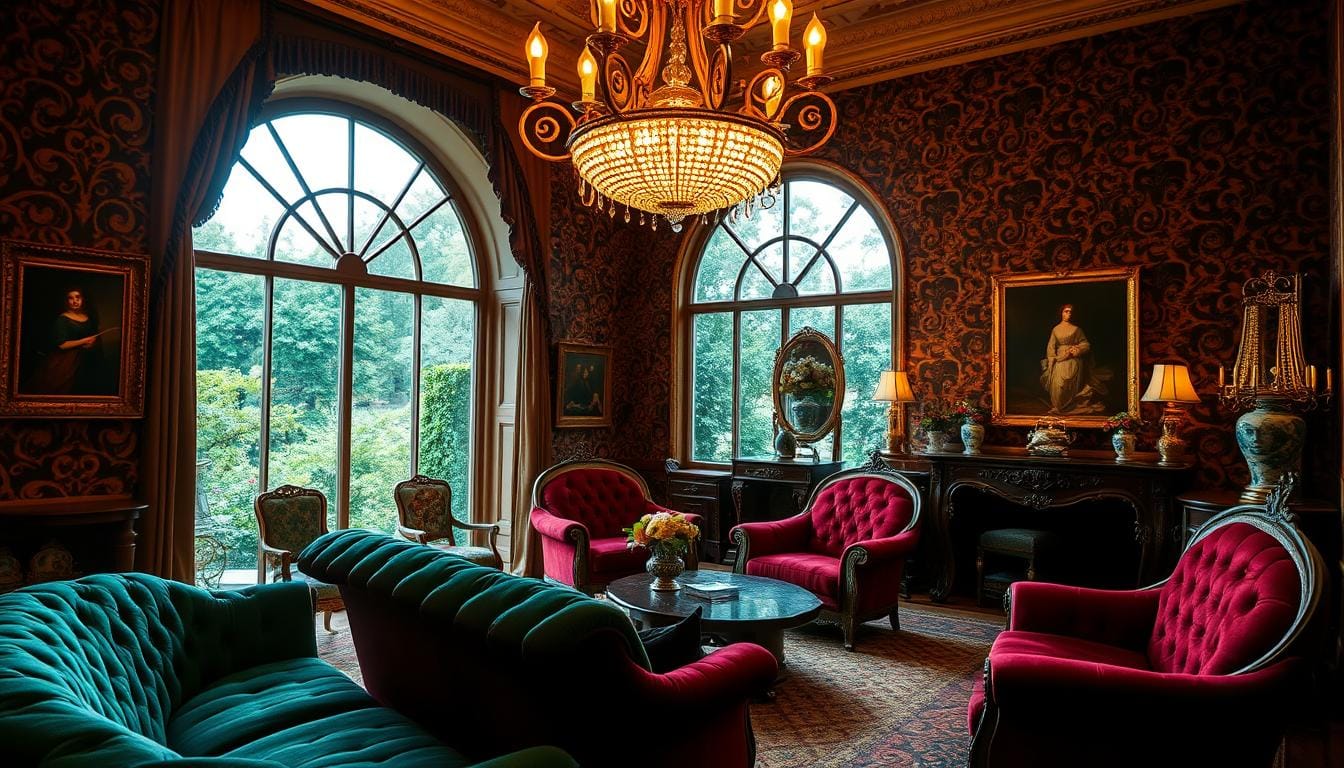Last summer, I visited a friend’s apartment that felt like stepping into a French palace. She’d mixed vintage candlesticks with blush-pink cushions and a mirror framed in curling gold leaves. “It’s my ‘modern Marie Antoinette’ phase,” she laughed. But here’s the twist: her space wasn’t stuffy or outdated. Instead, it buzzed with playful energy – exactly what today’s design lovers crave.
That experience taught me something: historical elegance can feel fresh again. The original 18th-century French style wasn’t just for royalty. It celebrated comfort, conversation, and artistry – values we still cherish in our interior spaces. Now, this aesthetic is making a major comeback, according to Pinterest’s 2025 trend forecasts.
Why now? After years of stark minimalism, people want rooms that tell stories. They’re embracing curved furniture, delicate florals, and gilded accents that whisper “joy” instead of “perfection.” The best part? You don’t need a château budget. Even small touches – like a vintage-inspired lamp or hand-painted tray – can create that dreamy, romantic vibe.
In this guide, I’ll show you how to blend this ornate era with modern living. We’ll explore easy updates, balance bold details with function, and make your home feel like a personal sanctuary. Ready to fall in love with interior design that’s equal parts whimsical and wearable? Let’s begin.
Understanding the Rococo Aesthetic
Researching 18th-century French salons changed how I view modern interiors. These spaces weren’t just fancy rooms – they were rebellion in physical form. After decades of strict Baroque grandeur, designers began embracing curves that felt alive and details that sparkled like champagne bubbles.
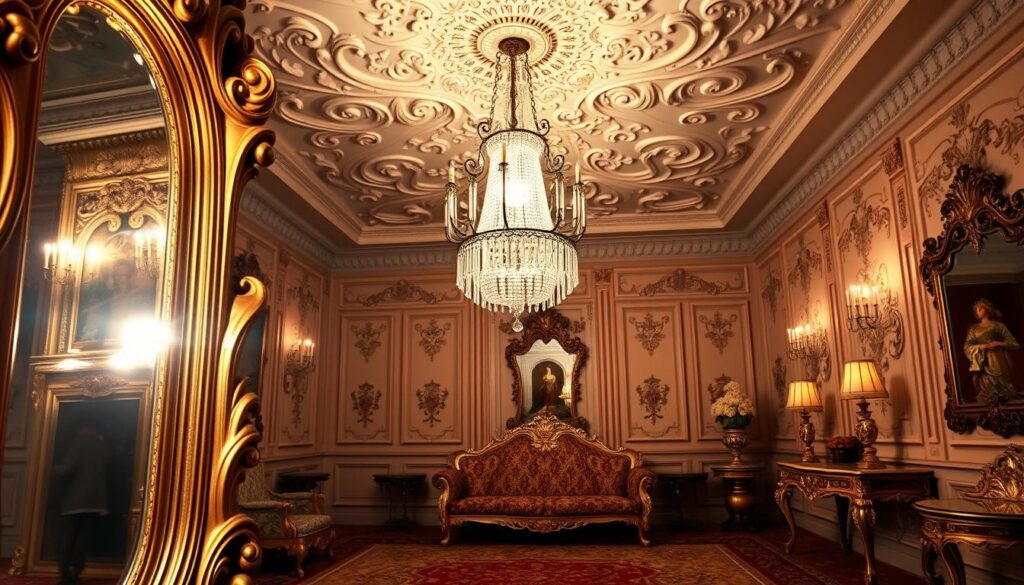
A Brief Historical Overview
Louis XV’s reign brought a design revolution in the 1700s. Aristocrats swapped Versailles’ formality for Parisian townhouses filled with organic shapes and whispered secrets. I once held a teacup from this era – its handle curved like a lover’s embrace, proving comfort became as important as appearance.
Key Elements That Define the Style
Three features make this aesthetics timeless:
- Nature’s fingerprint: Vines crawling up chair legs, seashells hiding in ceiling corners
- Color poetry: Think dawn skies (pale blue) and rose petals (blush pink) softened with cream
- Light play: Gold leaf applied not for show, but to make candlelight dance across rooms
What fascinates me most? The intentional imperfections. A mirror frame might have one extra floral carving – proof that beauty beats symmetry. This approach feels surprisingly modern in our curated Instagram age.
Exploring the Intricate World of Rococo Design
While studying an 18th-century writing desk at a museum, I noticed something unexpected – tiny bronze flowers winding around its legs like climbing vines. This delicate touch revealed the essence of Rococo design: finding magic in details that serve no purpose but joy.
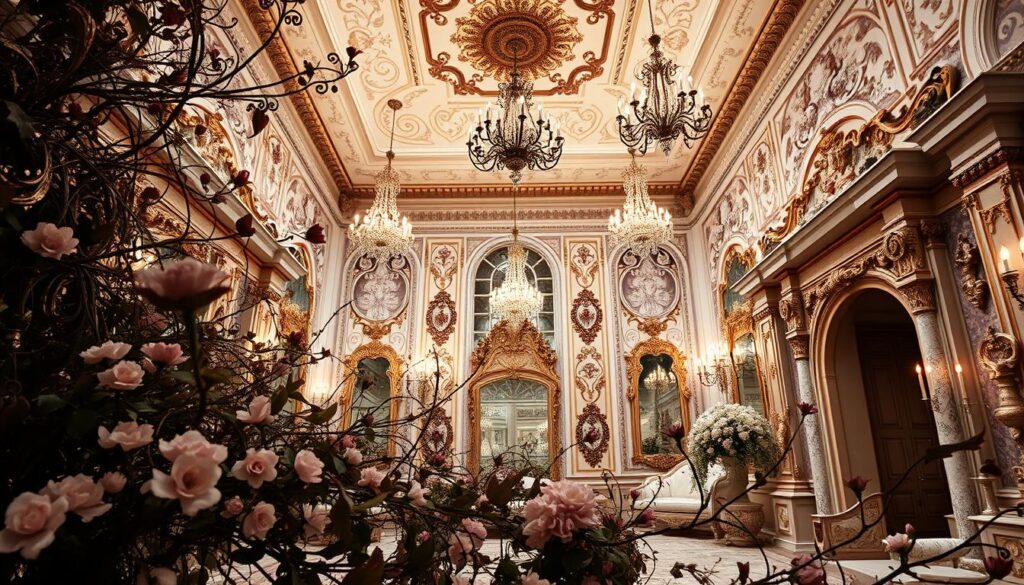
The Shift From Grandeur to Grace
Where Baroque style shouted power through massive columns and dark woods, Rococo whispered romance with curving sofas and pearly pastels. I’ve always loved how this elegance prioritized human connection – chairs arranged for face-to-face chats, not throne-like rows.
Three innovations defined this transformation:
- Nature as blueprint: Furniture legs became tree branches, walls bloomed with floral carvings
- Lightness over weight: Gilded mirrors multiplied sunlight instead of absorbing it
- Craftsmanship as poetry: Artisans signed works hidden inside drawers – pride in every stitch
What fascinates me most? The term itself combines “rocaille” (shellwork) and “Baroco,” marking both rebellion and evolution. These spaces didn’t just look different – they felt different. A carved cabinet wasn’t just storage; it became a conversation piece celebrating the maker’s hand.
Today’s interiors can borrow this philosophy: choose one statement piece with intricate texture, then let it shine against simpler backdrops. That writing desk I admired? It’s proof that true artistry needs no explanation – just appreciation.
Incorporating Rococo Revival Decor into Contemporary Homes
During a design workshop, a participant asked how to add drama without clutter. Our solution? Strategic use of ornate accents. The magic happens when you treat rococo style elements like jewelry – a little sparkle goes further than you’d think.
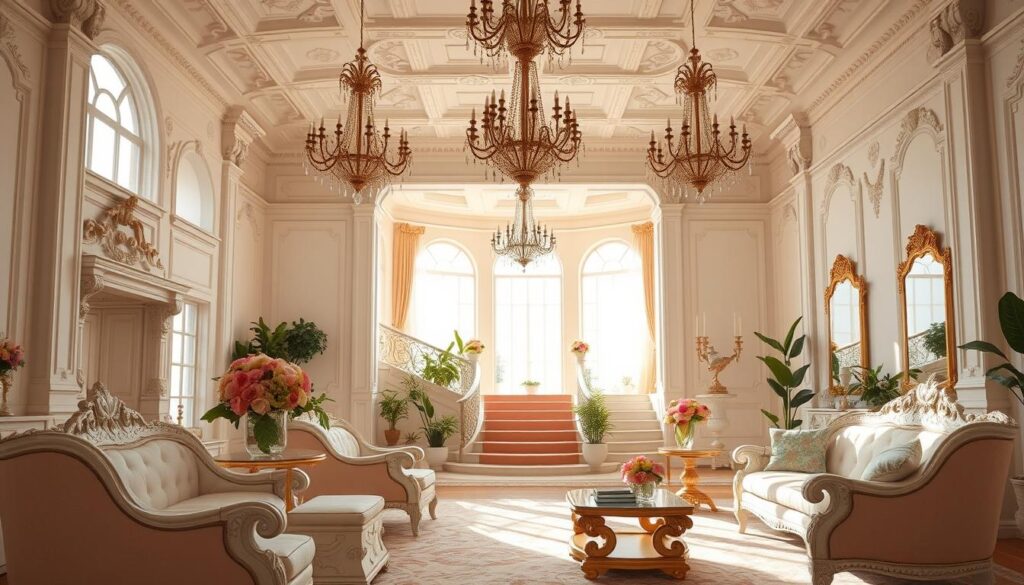
- Edit fiercely: Choose one showstopper piece per room – maybe a carved console or velvet settee
- Update finishes: Try matte gold instead of shiny gilt to soften traditional design
- Ground with neutrals: Let intricate details pop against clean walls and simple flooring
Blending Ornate Details with Modern Minimalism
Last month, I transformed a client’s bland entryway using just two items: a sleek bench and an over-the-top mirror. The contrast made both pieces shine. This approach keeps spaces feeling fresh, not frozen in time.
For those nervous about commitment, start small. A scalloped lamp base beside geometric shelves creates instant tension. Or layer a floral-print pillow on a modern sofa. The key? Let each touch feel intentional, not accidental.
Remember – today’s interior design celebrates personality over perfection. Mix eras like you’d mix friendships: finding harmony in unexpected pairings.
Designing with Soft Pastels and Gilded Accents
Last month, a client showed me her all-gray living room and sighed, “It feels like a rainy Monday morning.” Together, we transformed it using peachy walls and champagne-toned curtain rods – proof that color choices can rewrite a room’s entire mood.
Choosing the Perfect Color Palette
Think of your color palette as a love letter to light. Start with whisper-soft hues like buttermilk yellow or lavender mist for walls. These act as a canvas for richer accents. Here’s my go-to formula:
- 60% base: Pale neutrals (try Benjamin Moore’s “First Light”)
- 30% personality: Muted greens or blues in textiles
- 10% drama: Metallic touches or deep jewel tones
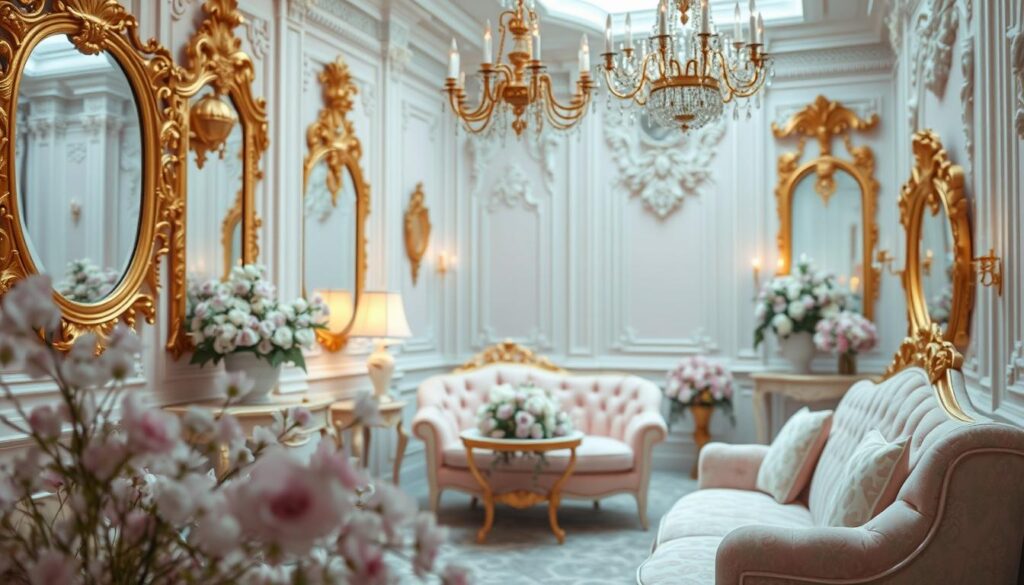
I’ve found that soft pastels work best when layered. Pair a blush throw pillow with mint-green vases – the combo feels fresh, not saccharine.
Enhancing Spaces with Gold and Metallic Touches
Gold accents should wink, not shout. Try these subtle upgrades:
- Brass drawer pulls shaped like twisting vines
- Mirror frames with distressed gilt edges
- Table lamps casting warm pools of light
For restaurant design inspiration, notice how professionals use metallic finishes to highlight dining areas without overwhelming guests. Apply this approach at home by focusing metallic elements where light naturally plays – near windows or under fixtures.
Remember: every gilded detail should have a purpose. A single gold-leaf tray holding citrus fruits says “considered luxury” better than a room full of shiny objects.
Curved Furniture and Intricate Carvings
Last weekend at a flea market, I stumbled upon a walnut chair with legs that seemed to sway like ballet dancers. Its graceful curves stopped me mid-stride – proof that furniture shapes can transform a space before you even consider color or fabric.
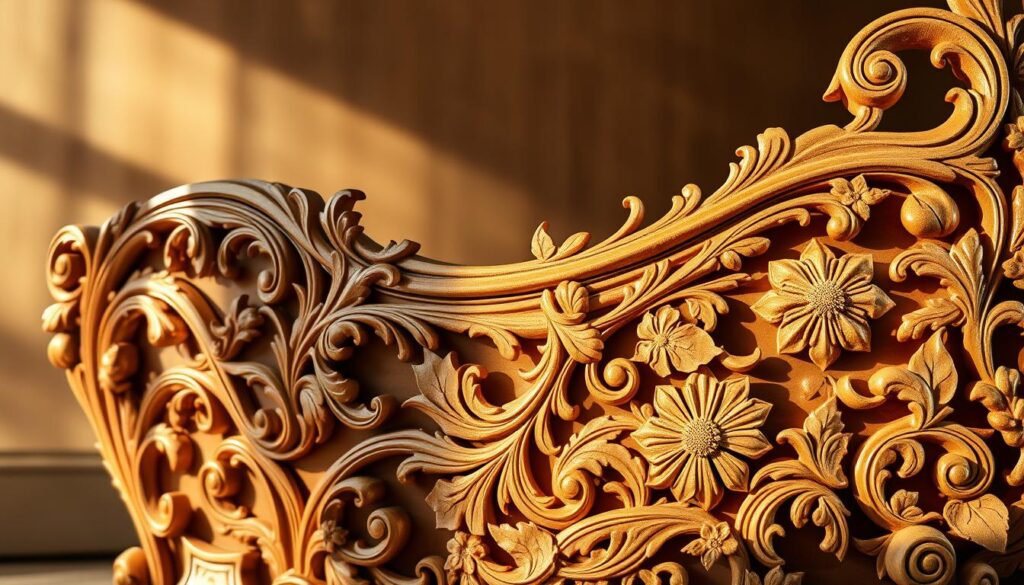
Selecting Sculptural Furniture Pieces
Cabriole legs aren’t just historical quirks – they’re design magic. Those signature S-shaped lines soften angular rooms better than any throw pillow. I recently placed a curved settee in a client’s boxy entryway, and suddenly, the whole room felt like it was breathing.
Here’s how to choose pieces that sing:
- Start small: A side table with carved details adds intrigue without shouting for attention
- Mix eras boldly: Pair a tufted Rococo-inspired chair with a sleek metal desk
- Follow the light: Place curved pieces near windows to highlight their silhouettes
I’ve seen clients fall in love with vintage home decor ideas once they realize how one ornate mirror frame or carved drawer pull can elevate simple shelves. Remember: these touches work best when they feel discovered, not staged. Let that gilded console look like it’s always belonged in your modern living room – because now, it does.
Enhancing Interiors with Luxurious Textiles and Romantic Lighting
Last spring, I helped transform a client’s sunroom from bland to breathtaking using nothing but fabric and light. As we layered sheer curtains over velvet cushions, she gasped: “It’s like the room learned to blush!” This magic happens when textiles and lighting work together to craft atmosphere.
Exploring Rich Fabrics and Layered Rugs
Start with tactile contrasts that invite touch. Pair heavy brocade throw pillows with airy linen drapes – the combo adds depth without weight. For bedding, try ruffled cotton sheets under a quilted satin coverlet. My favorite trick? Layering a floral-patterned rug over neutral carpeting. The double textiles create visual intrigue while softening footsteps.
Creating Ambience with Chandeliers and Sconces
Lighting should dress your space like jewelry completes an outfit. A crystal chandelier above a dining table casts rainbows at sunset, while brass wall sconces give hallways golden glow. For modern interior design lovers, try clear glass pendants – they offer sparkle without competing with other details.
Remember: warm bulbs (2700K-3000K) make gilded frames shimmer and pastels blush. Place fixtures to highlight your best features – a sconce beside artwork, or a chandelier centered over floral-patterned chairs. When dusk falls, your home becomes a lantern of comfort, every touch of light whispering “stay awhile.”
Using Floral Motifs and Decorative Accessories
Last Tuesday, I transformed a client’s breakfast nook using nothing but a roll of ivy-patterned wallpaper and two embroidered pillows. As sunlight hit the new floral motifs, she exclaimed: “It’s like spring decided to move in permanently!” This magic happens when nature’s artistry meets intentional design.
Bringing the Garden Indoors
Start with walls that tell stories. A chinoiserie mural behind your dining table creates depth, while subtle blossom prints add texture to hallways. For smaller touches, try ceramic orchid sculptures on shelves or metal leaf bookends. My favorite trick? Layer a botanical-print throw over a modern sofa – instant warmth without commitment.
Balance is key. Let one rococo-inspired element shine as the star – maybe a gilded birdcage chandelier – then keep other accessories simple. Remember: these motifs should feel discovered, not staged. A single peony-patterned tray holding your morning coffee turns routine into ritual.
Your home isn’t a museum. Mix eras like you’d mix flowers in a vase – wild roses with structured tulips. When done right, every glance reveals new details, and every room whispers: “Stay awhile, the garden’s just begun.”
